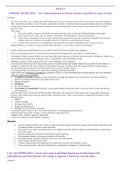Samenvatting
Summary for all content of Etiology of Offender Types. I studied with it and I had a 9
- Vak
- 4.2C (FSWP4025F)
- Instelling
- Erasmus Universiteit Rotterdam (EUR)
It has all required literature we had to read for this course. 4 weeks in total. It comes with images and examples. It's organized in chronological order and it's quite detailed. I studied with it and I was prepared for the exam.
[Meer zien]




